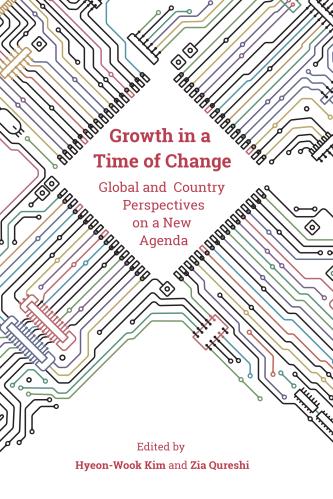A growing chorus of expert opinion predicts that COVID-19 will slow down the forces of globalization, with obituaries being written for its impending death. The pandemic, many say, will be the final straw in a long chain of events that have dented the momentum of global integration, including the China-U.S. trade war, Brexit, and economic nationalism in many parts of the world. As businesses and policy makers shift emphasis from economic efficiency to resilience and flexibility, the process of reshoring production is expected to accelerate, hastening the end of global economic integration.
Trade of manufactured goods has already been on a retreat since the Great Recession of 2008. After recovering from the sharp downturn in 2009, global trade in manufacturing—and more broadly value chain integration—has registered a secular decline since 2011 (Figure 1). According to the World Input-Output Database (WIOD), the share of foreign content in domestic production—a broad measure of manufacturing value chain fragmentation—has consistently declined after peaking at 25.4 percent in 2011. Facing rising wages in emerging economies and technological change that facilitated automation at home, multinational corporations in advanced economies have shown a reduced appetite for moving production abroad. The emerging view is that COVID-19 will reinforce this trend as it pushes economies to turn inward to avoid exposure to external economic and health shocks.
There is, however, an important caveat in this view: The trend of global integration is likely to diverge between services and manufacturing. Trade in services has increased at a faster rate than trade in manufactured goods during the period after 2000, and most recently since 2011 (Figure 1). Moreover, services trade fell at a much lower rate than trade in manufactured goods during the Great Recession, after which it continued to grow even as trade in manufactured goods set on declining path. The foreign content in domestic services output exhibited a similar pattern. This upward movement in services trade is likely to continue in the post-COVID-19 world, potentially compensating for some of the losses in value chain integration in manufacturing. Once the worst of the pandemic is behind us and lockdown restrictions are lifted, services are likely to rebound rapidly, and remain resistant to political and economic forces that threaten to reverse global integration.
Although services account for 75 percent of GDP and 80 percent of employment in OECD countries, the current value of services trade globally is only one-third of that of manufactured goods. This is in spite of the fact that the service sector includes many tradeable activities, such as information and communications technology services, financial intermediation, insurance, and professional, scientific, and technical services. Tradeable business services have a greater share of employment than manufacturing in many advanced economies, although their contribution to cross-border trade and production networks remains less understood due to data and measurement challenges. The large size of the services sector and relatively large wage differences across countries will provide a vast potential for service-based global integration.
The coming decades are likely to see greater service integration, even as manufacturing becomes concentrated for several reasons:
1. The same technological shifts that are reducing the cost advantage of offshoring production to low-cost emerging countries will also facilitate greater service integration. As technologies for teleworking, “telerobotics,” and “telemedicine” mature, they will enable a greater degree of virtual service delivery, allowing workers to offer services from a distance. COVID-19 can particularly help bring teleworking to the mainstream by changing attitudes and facilitating favorable regulations.
Today, many activities, such as software development and scientific research, are done by virtual teams that work from a distance. The future could witness the fragmentation of specific service functions and tasks into different roles, allowing companies to outsource specific tasks to virtual service providers. The rolling out of 5G networks and wider adoption of cloud computing technologies will facilitate service globalization where tasks themselves, rather than factories, become fragmented. This process, which Richard Baldwin called “the third unbundling,” is likely to accelerate on the backs of expanding digitization, the rise of big tech firms, and business-to-customer and business-to-business e-commerce.
2. Trade in services could be less amenable to direct policy restrictions such as tariffs and quotas. More than a quarter of trade in services takes place between corporations and their subsidiaries, which makes it difficult for governments to monitor and control. However, trade in services could require a complementary movement of workers and certain standards and licenses. Companies that buy computing services over the internet, for instance, could require a software engineer to occasionally visit their sites to resolve technical problems or train staff. To an extent, therefore, a significant clampdown in the movement of people and goods will also affect the globalization of services.
3. As companies respond to political forces by reshoring manufacturing, they are likely to continue to depend on imported business services. Tradeable services are an important intermediate input in high-tech in manufacturing, which is also highly integrated into international production networks. New technologies will further make outsourcing services easier and cheaper, allowing companies to remain local but coordinate production globally. This will help dampen the cost of high-skilled labor in advanced economies, which is set to increase with demographic shifts and rapid changes in demanded skill sets.
Services, therefore, have a great potential to drive globalization in a post-COVID-19 world that will be reluctant to embrace more manifest forms of global integration. Much of the early growth is likely to take place among middle- and higher-income countries that have complementary high-skill labor endowments, which should make service globalization politically amenable. Unless countries institute artificial legal barriers to limit it, service integration is likely to rise significantly as technological change exponentially reduces the costs of coordinating activities across borders. Even as we bid farewell to the heyday of manufacturing globalization, we could be welcoming services as the new driving force of global integration.
The Brookings Institution is committed to quality, independence, and impact.
We are supported by a diverse array of funders. In line with our values and policies, each Brookings publication represents the sole views of its author(s).











Commentary
Could services drive globalization in the post-COVID-19 world?
June 17, 2020